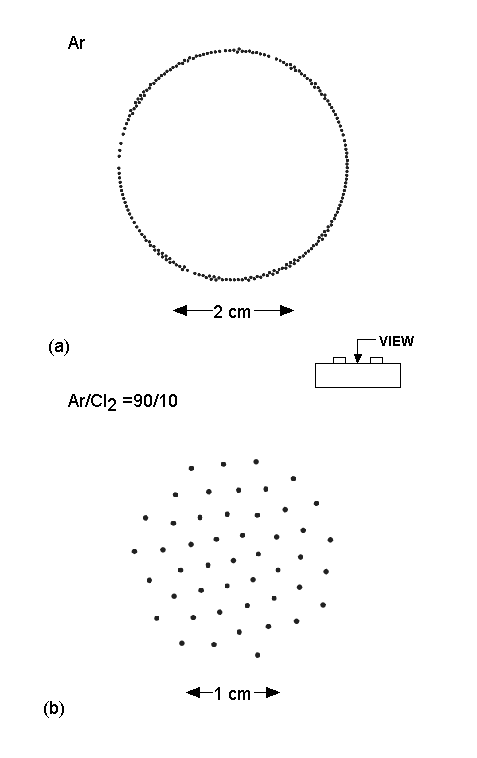

Coulomb Crystals in Plasma Processing Reactors*
Vivek Vyas and Mark J. Kushner
Department of Electrical & Computer Engineering
University of Illinois at Urbana-Champaign
1406 W. Green St., Urbana, IL 61801
1. Introduction
Dust particle transport in partially ionized plasmas has been the focus of many recent investigations as a consequence of concern over particle contamination of wafers during plasma processing of microelectronic devices and for the use of particles to study non-ideal plasmas. Particles in plasmas charge negatively to balance the flux of electrons and ions to their surfaces. As a consequence, the transport of these particles is governed by both mechanical (fluid drag, thermophoresis, gravity) and electrical (ion drag, electrostatic) forces. Particle-particle Coulomb interactions become important when the dust density is high enough that the interparticle spacing approaches the plasma shielding length, such as within a trapping site. For these conditions, particles interact through Debye shielded Coulomb forces. If the density of the particles reaches a critically high value, particles display collective behavior; a system typically referred to as a Coulomb solid or liquid.
2. Computational Model
A self-consistent three-dimensional model, the integrated HPEM-DTS has been developed to address particle transport in low temperature plasmas. The Hybrid Plasma Equipment Model (HPEM) is a comprehensive simulator of low-pressure plasma reactors. The Dust Transport Simulation (DTS) is a three-dimensional model in which the trajectories of dust particles are integrated based on mechanical and electrical forces. The forces included in the module are ion drag, fluid drag, electrostatic, thermophoretic, coulomb, self-diffusive, gravity and Brownian motion. Dust particles interact with other plasma species through their charge density which, when included in solution of Poissonís equation, perturbs the electric potential. They also interact by providing surfaces internal to the plasma upon which heterogeneous chemistry can occur, including recombination of charged particles. Particles are also sources of momentum loss for electrons and ions through collisions. In order to self-consistently model the behavior of dusty plasmas, the DTS has been integrated as a module of the HPEM. The effect of varying the bias voltage of a capacitively coupled discharge, gas chemistries, particle diameter, and the number of particles on the propensity for crystal formation has been investigated.
3. Results
Typical morphologies of Coulomb crystal lattices, as observed from the top of the reactor, are shown in Figure 1. Configurations are shown for low (150 V) and high (250 V) substrate biases. At the lower bias, a single disk-shaped lattice of dust particles, 1 layer thick, is obtained which is confined to the center of the potential well. As the bias is increased (> 200V), a void forms in the center of the crystal, resulting in an annular lattice. The larger radial ion-drag forces at higher biases are responsible for the formation of a void.
 |
| Fig. 1: Top view of particle positions (4.9 microns) in an Ar discharge (95 mTorr, 300 sccm). |
As dust particles settle into the potential well forming a Coulomb solid, the resulting lattice often oscillates about an equilibrium position, as shown in Figure 2. These radial, horizontal oscillations are the result, in part, of the mutual repulsion of the particles in the presence of a restoring force, in this case both gravity and electrostatic plasma forces. Here the repulsive force is also augmented by a radially outward ion drag force. For typical conditions (Ar, 95 mTorr, 10 W, 4 micron particles), we observe an oscillation frequency of 5 Hz.
 |
| Fig. 2: Horizontal oscillations (5 Hz) of particles in an Ar discharge (95 mTorr, 10 W, 4 micron particles). |
The morphology of Coulomb crystals in electronegative plasmas has been the focus of recent investigations. The negative ion density in an electronegative plasma can often greatly exceed the electron density. As a consequence, the ion drag force acting on the dust particles and the charge on particles can be different, leading to qualitatively different crystal morphologies than those found in electropositive plasmas. The crystal morphologies for pure argon and Ar/Cl2 = 90/10 are compared in Figure 3.For pure Ar, the particles settle in a ring-shaped configuration. On increasing the Cl2 fraction to 0.1, the void closes and the particles settle into a single, small disk-shaped structure. The shape of the crystals is dominantly a function of a change in the direction of the ion momentum flux. The mass averaged ion momentum flux exerts an outward ion-drag on the particles in pure Ar which leads to the formation of a void (see Fig. 4a) whereas in Ar/Cl2 plasmas, the net ion-momentum flux pushes particles to the center of the reactor and causes the void to close (see Fig. 4b).
 |
| Fig. 3: Plasma crystal morphologies in an Ar/Cl2 discharge (14 sccm, 0.14 Torr, 40W). (a) Pure Ar. b) Ar/Cl2 = 90/10. |
 |
| Fig. 4: Electron density and ion-momentum-flux vectors in rf discharge (14 sccm, 0.14 Torr, 40W). (a) Pure Ar and (b) Ar/Cl2 = 90/10. |
4. References
*This work was supported by Sandia National Laboratories, Semiconductor Research Corporation and the National Science Foundation (CTS 99-74962, CTS03-15353).
Last updated: August 21, 2003.